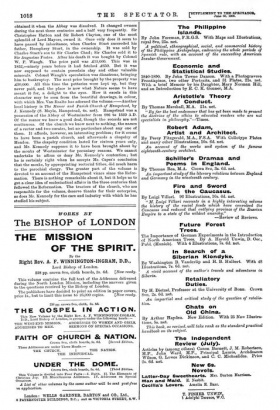TWO LOCAL HISTORIES.
Brownsea Island. By Charles Van Raalte. (A. L. Humphreys. 12s. net.)—Brownsea Island—there are many variants of the spelling of Brownsea—lies at the entrance to Poole Harbour, a position which in old days gave it importance for purposes of defence. It came in pre-Conquest days into the possession of Came Abbey ; whether this tenure was continuous it is difficult to say. Mr. Van Raalte thinks that Robert, Earl of Morton, had it after the Conquest. Anyhow, John Vere, Earl of Oxford, obtained it when the Abbey was dissolved. It changed owners during the next three centuries and a half very frequently. Sir Christopher Hatton and Sir Robert Clayton, one of the most splendid of Lord Mayors, owned it. Once only does it seem to have passed by inheritance, when Charles Sturt succeeded his father, Humphrey Sturt, in the ownership. It was sold by Charles Sturt's son to Sir Charles Chad ; Sir Charles sold it to Sir Augustus Foster. After his death it was bought by Colonel W. P. Waugh. The price paid was £13,000. This was in 1852,-ninety years before it had fetched £650. But it was now supposed to contain porcelain clay and other valuable minerals. Colonel Waugh's speculation was disastrous, bringing him to bankruptcy. The next price brought by the property was £.30,000. All this time the potteries were kept up, but they never paid, and the place is now what Nature seems to have meant it for, a delight to the eyes. How it excels in this character may be seen from the beautiful drawings, in colour, with which Mrs. Van Raalte has adorned the volume.-Another local history is The Manor and Parish Church of Hampstead, by J. Kennedy (S. Mayle, Hampstead, 4s. net). Hampstead was a possession of the Abbey of Westminster from 986 to 1539 A.D. Of the manor we know a good deal, though the records are not continuous. Of the church we know next to nothing, the names of a rector and two curates, but no particulars about any one of them. It affords, however, an interesting problem; for it seems to have been a parish church, and afterwards a chapelry of Hendon. The chapelry condition lasted for sixteen years only, and Mr. Kennedy supposes it to have been brought about by the monks of Westminster for pecuniary reasons. We cannot undertake to affirm or deny Mr. Kennedy's contention ; but he is certainly right when he accepts Mr. Capes's conclusion that the monks, by appropriating rectorial tithes, did much harm to the parochial clergy. The greater part of the volume is devoted to an account of the Hampstead vicars since the Refor- mation. There is nothing remarkable about it, but it helps us to get a clear idea of ecclesiastical affairs in the three centuries that followed the Reformation. The trustees of the church, who are responsible for the volume, deserve thanks for their enterprise, as does Mr. Kennedy for the care and industry with which he has studied his subject.



























































 Previous page
Previous page